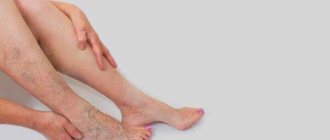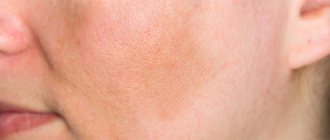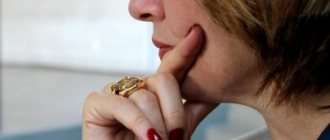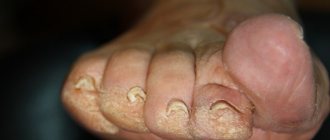Healthy nails appear pink in color, with a smooth, smooth surface and a slight natural shine. If they don't look right, this indicates a problem within the body or directly with the nails.
Changes in the color of the plate are called dyschromia in medicine. The color is distorted throughout the plate or in individual areas. Dyschromia of nails in the form of spots of white, red, yellow, blue, brown or black is more common. The reasons for their appearance are diseases of the liver, kidneys or heart, the influence of external factors, infections, and deterioration in the nutrition of the nail apparatus. Let's look at them in more detail depending on the color.
Causes of the disease
While other types of melanoma are often associated with excessive sun exposure, here the situation is radically different. Most often, this type of oncology develops on the toes, which are constantly protected from sunlight. Therefore, the causes of subungual melanoma do not include insolation, they look like this:
- mechanical injuries of the nail. This includes surgical and cosmetic intervention options in which the nail plate is damaged;
- physical injuries: burns, frostbite, etc.;
- chemical injuries. Usually we are talking about long-term exposure to aggressive chemicals, for example, in production;
- heredity. Up to 14% of all patients diagnosed with nail melanoma have mutations in certain genes4
- existing benign neoplasms, for example, dysplastic nevi, which are prone to transformation into malignant ones.
Most often, this disease occurs in people over 60 years of age. And there is another interesting fact: obviously, it depends on the race, because representatives of the Negroid, as well as Mongoloid races, suffer from the disease much more often - 40% more often than Caucasians. Among the latter, people at risk are fair-skinned, red-haired people, as well as people with a lot of freckles.
Blue
Blue spots, like black spots, most often appear due to injury. Even minor injuries that were not immediately noticed or quickly forgotten about cause the plate to turn blue.
Other reasons why blue spots form on nails are associated with diseases of the heart, blood vessels, and lungs, when the blood is poorly saturated with oxygen or the circulation in the extremities is impaired.
Deficiency of iron and vitamin B12 provokes blue nails due to the development of iron deficiency anemia.
The most dangerous cause of blue spots is a glomus tumor of the nail phalanx, which looks like a dark blue bruise. This is a serious lesion that requires surgery.
Types and symptoms
The classification of nail melanoma provides for two variants of the course of the disease: horizontal and vertical stages. Symptoms of the disease will depend on what type we are talking about.
In the horizontal stage, the patient observes a brown or black stripe on the nail (under the plate). The strip is not necessarily uniform; it can expand, capture more of the free nail edge, and transfer to the skin.
During the vertical stage, the tumor begins to grow into the surrounding tissues, deformation of the nail occurs, and it becomes fragile. As the tumor grows, the nail cracks, the surface becomes covered with bumps, and at the slightest mechanical impact it begins to bleed. The pigment in this case can also be either brown or black.
It is important to understand that nail melanoma can be non-pigmented until a serious stage. For this reason, until the tumor begins to spread vertically, it may not be noticed. This is typical for approximately 30% of cases.
Not always, but the disease can also manifest itself with the following symptoms:
- burning, itching in the area of the tumor;
- feeling of fullness;
- pain that increases as the tumor develops;
- decreased functionality of the limb.
Common symptoms on the toenail or fingernail include fever, weakness, and severe weight loss. With the development of metastases, local symptoms are added - those that are characteristic of diseases of the affected organs.
Are you experiencing symptoms of nail melanoma?
Only a doctor can accurately diagnose the disease. Don't delay your consultation - call
White
White spots or leukonychia are the most common type of dyschromia; they are usually not dangerous to health and are regarded as a temporary cosmetic defect. At least once in their lives, adults and children had white spots on their nails.
Why are they formed? Essentially, these are air bubbles trapped between the bed and the nail plate. At the site of the bubble, the nail retreats from the vascular skin, and a white spot appears on a pink background.
Leukonychia occurs in the form of dots, transverse stripes or wide spots.
The list of causes that causes it includes:
- Allergy to nail polish, hardener, remover or other manicure products;
- Fungal infection, white superficial onychomycosis. Initially, small white dots are visible, then the infection spreads to the entire plate. Nails peel, thicken, crumble;
- Injuries to the plate or nail matrix. Impacts, pinching, injuries during manicure or pedicure, wearing artificial surfaces;
- Lack of protein, zinc, calcium, iron in the body due to an unbalanced diet or metabolic disorders;
- Tight shoes. This is the reason why white spots appear on the toenails;
- Taking certain antimicrobial medications or treatment with chemotherapy drugs;
- Heavy metal poisoning.
It is not always possible to determine the exact reason why white spots appear on the nails of the fingers or toes. To do this, it is better to contact specialists.
If the stain is only on one finger, then most likely the cause is injury. As the plate grows, it will move to the free edge and leave along with the cut part of it.
If there are a lot of spots, you need to go to the doctor, because it is a matter of systemic disorders. When poisoned or taking medications, leukonychia appears as long light transverse stripes. With onychomycosis, the boundaries of the spots are unclear.
The doctor will examine your fingers and prescribe additional tests. In case of a systemic disorder, the underlying disease is treated. If leukonychia is caused by side effects of medications, the doctor will recommend an alternative. For onychomycosis, the affected area is cleaned, and then fungicidal ointments or creams are applied daily. In case of nutrient deficiency, vitamin and mineral complexes are prescribed.
Stages of the disease
The classification of nail melanoma involves (like any other cancer) several stages:
- zero (in situ). At this stage, non-invasive damage by malignant cells is detected;
- first. The thickness of the formation is either up to 1 millimeter or up to 2, but without ulceration;
- second. It is placed if the thickness of the tumor is no more than 2 millimeters or no more than 4, but without ulceration;
- third. It is placed regardless of the size of the melanoma itself, provided that metastases are detected in the regional lymph nodes;
- fourth. Suggests the presence of metastases in internal organs.
Obviously, the lower the stage, the higher the patient’s chances of effective treatment and longer life expectancy.
Diagnostics
Diagnosing melanoma under the nail is not so easy, because it is often similar to other diseases or problems, for example, subungual hematomas. To exclude simpler situations and make an accurate diagnosis, doctors use dermatoscopy (examination of tissue under high magnification), as well as epiluminescence microscopy. The latter method involves examining changed areas of tissue in a special environment. Thanks to it, it is possible to distinguish a benign disease from a malignant one.
Cytological studies are carried out, but a biopsy in this case is undesirable, since it can provoke the development of metastases. Additional tissue examination is carried out after surgery, when the tissues are removed.
If nail melanoma is not excluded after examination, marginal resection of the nail is performed followed by tissue examination. When the diagnosis is confirmed, the patient is indicated for radical surgery.
Additionally, the following research methods are used:
- Ultrasound;
- CT;
- MRI.
They are needed to verify the presence or absence of metastases.
Folk remedies
Our great-grandfathers learned how to eliminate such a problem as a black dot on the nail of the big toe. For example, vinegar baths and compresses will not only remove stains, but can also serve as a preventive measure against fungus. For the best effect, apply compresses for at least 20 minutes. Tea tree oil also helps a lot. The healing mixture consists of grated laundry soap and a drop of oil. Use the lotions twice a day for half an hour. Olive oil, a decoction of parsley with salt, and herbal decoctions help.
How the treatment works, methods
The main treatments for melanoma under the nail include:
- resection at the level of the middle phalanx of the finger. The formation is removed in such a way as to preserve the patient’s quality of life as much as possible;
- radiation therapy. It is carried out to exclude tumor recurrence in the area of surgical scars, as well as to influence the primary lymph nodes to prevent the development of metastases;
- chemotherapy. Depending on the situation, it can be used before surgery and after surgery. There are different program options that are selected individually;
- immunotherapy. The use of certain drugs prolongs the period without recurrence and increases the overall survival of patients with this type of cancer.
It is assumed that gene therapy can also play a positive role in treatment.
Complications and prognosis
With the development of nail melanoma, the risk of metastases is very high. As a rule, they appear in the liver and lungs. However, resection does not protect 100% from these processes.
Another difficulty is that surgery always (but to varying degrees) reduces the functionality of the limb. Patients also experience psychological difficulties, since their lifestyle changes, and in the case of hand operations, difficulties arise with the perception of their new appearance, which is difficult to hide from others.
In the absence of metastases, the five-year survival rate of patients is about 60%, but if metastases are already present, the average survival rate ranges from 7-8 months. The specific timing depends on individual characteristics, as well as the size, thickness of the tumor and other factors.
Preventing stains on nails
Reconsider your lifestyle in terms of body care and personal hygiene. A few simple rules will reduce the likelihood of stains developing:
- To prevent fungus, use slippers when showering outside the home - often showers in the gym are a breeding ground for fungus.
- Browse the shoe rack. Shoes that rub and cause discomfort can damage the nail plate and cause hematomas, as well as affect the formation of pathologies such as flat feet or protruding bones.
- Take vitamins containing calcium.
- Maintain personal hygiene.
- Don't use someone else's shoes.
Disease prevention
Prevention of subungual melanoma can include:
- protection of fingernails and toenails from physical and chemical injuries, exposure to aggressive chemicals;
- additional examinations of those people who have had cases of melanoma among their close relatives;
- monitoring existing benign neoplasms (nevi) and their timely removal.
Also, do not ignore the primary signs of melanoma of the nail plate. In many cases, they talk about other, simpler symptoms or diseases, but you shouldn’t count on it.
Brown
Why do brown spots appear on nails?
They talk about the following violations:
- problems with the kidneys;
- increased iron content in the blood;
- hormonal imbalance, Addison's disease or adrenal insufficiency;
- diabetes mellitus with complications in the form of trophic disorders;
- fungal infection caused by trichophyton red;
- long-term use of certain medications (zidovudine, gold preparations).
Various factors lead to spots on the nails of one color or another. It is impossible to competently understand this problem on your own. You need to consult a doctor, take additional tests, undergo examinations to understand why dark or light spots appear on your nails. For the health of nails and the whole body, it is important to eliminate the cause of the stains, and not to mask them with colored varnishes. And prevention requires proper care, proper nutrition and protection from harmful external influences.
0 0










